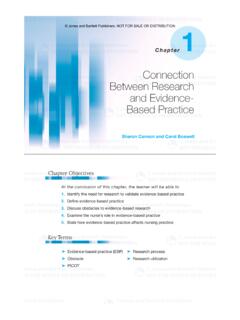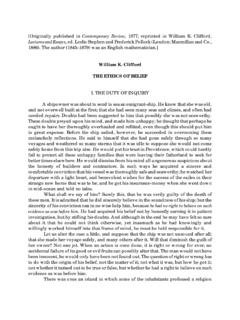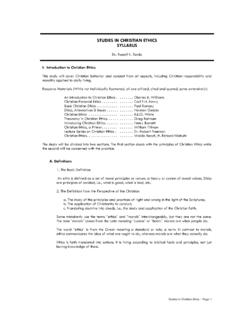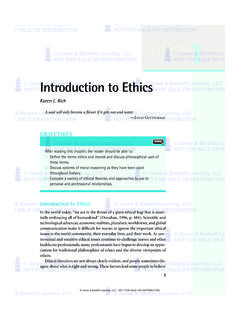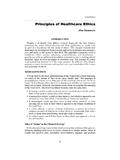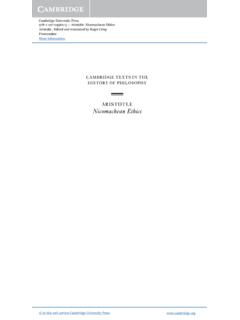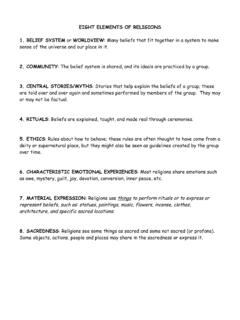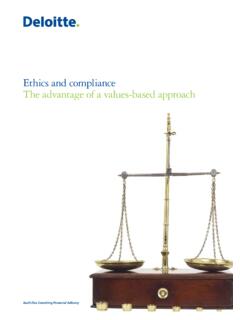Transcription of Ethics in Organizations and Leadership
1 Ethics in Organizations and LeadershipJanie B. ButtsCHAPTER 4 119 Ethics must begin at the top of an organization. It is a Leadership issue and the chief execu-tive must set the example. FORMERCHIEFJUSTICEEDWARDHENNESSEY,MASSAC HUSETTSSUPREMEJUDICIALCOURTOBJECTIVESA fter reading this chapter, the reader should be able to:1. Discuss the significance of an open system for health care Explore the ethical dimensions that shape the culture of an Compare the similarities and differences between the traditional cultures of anorganization and Daft s unique list of Explore the rationale for the two principles necessary for trust to exist between thecommunity at large and the Specify the elements that help to explain the rationale for the critical nature oftrust in nurses and the common unethical and illegal behaviors that people sometimesexhibit in Briefly explore the history of the adoption of compliance programs and officers inhealth care
2 Identify the reasons for health care fraud occurrences in the year Examine Pearson et al. s characteristics of an exemplary ethical 9/25/07 4:21 PM Page 119 Jones and Bartlett Publishers. NOT FOR SALE OR DISTRIBUTION10. Discuss prevention strategies for health care fraud and other unethical or illegalbehaviors in After thinking of a person that you have labeled as an ideal leader in your personallife, compare and contrast your ideal leader s characteristics with the characteris-tics of an exemplary leader listed in the Analyze your level of morality about a situation involving a possible conflict ofinterest by taking the 8-item test of rightness or cultureAdaptability cultureMission cultureClan cultureBureaucratic cultureOrganizational trustFiduciary relationshipsOrganizational ethicsCompliance programsCorporate fraudHealth care fraudBilling for services not rendered Upcoding of servicesUpcoding of itemsDuplicate claimsUnbundlingExcessive servicesMedically unnecessary services KickbacksQui tamlawsuitsConflict of interestEthical
3 LeadershipEthical communicationEthical qualityEthical collaborationEthical succession Ethical tenureplanningEthical OrganizationsAn organizationis defined as a group, in number from two people to tens of thou-sands, that intentionally strives to accomplish a shared common goal or set of are systems, meaning that an organization consists of highly integratedparts or groups to accomplish shared goals. An organizational system is composed ofinputs (resources monetary and human), processes (how the organization moves toachieve goals), outputs (products or services), and outcomes (end results or benefits toconsumers). An open system, such as a health care organization, focuses on external relation-ships, which places the organization in a larger context or environment (Boyle,DuBose, Ellingson, Guinn, & McCurdy, 2001).
4 An open system consists of relationswith suppliers, regulatory bodies, customers, allies, and competitors. These externalinfluencers help to guide the internal processes of the organization. An example of an120 CHAPTER 4: Ethics IN Organizations AND 9/25/07 4:21 PM Page 120 Jones and Bartlett Publishers. NOT FOR SALE OR DISTRIBUTION external influence is the Joint Commission (JCAHO) accrediting agency. For theaccreditation and review process, administrators develop an internal structure and cre-ate roles to assist and coordinate, such as the role of a compliance officer. Because ofthe open system relationships, ethical issues emerge at a new culture refers to an organization s beliefs, values, attitudes, ide-ologies, practices, customs, and language.
5 Even when the beliefs of the organizationstem from the chief executive officer or the board of trustees, managers and employeesneed to be loyal and committed to the organization s goals for a culture to be that shape an organizational culture are highlighted in Box Howadministrators and other people answer the questions in Box will determine theethical environment of the organization. Researchers ( , Cartwright & Cooper, 1993; Zammuto & Krakower, 1991; ascited in Boyle et al., 2001) have indicated that four definitive characteristics can makeup cultures in Organizations . The traditional view of organizational cultures identifiedby these researchers :This culture s descriptors include centralization; individual power and deci-sion making; autocratic, patriarchal power; fear of punishment; and implicit values are control, stability, and :This culture s descriptors include a hierarchical structure, emphasison formal procedures and rules, clearly defined role requirements and boundariesof authority, minimized risks, an impersonal and predictable work environment,employees as cogs or slots, and positions more important than people.
6 The valuesinclude efficiency, predictability, production, and and innovation:This culture s descriptors include an emphasis on theteam, a strong belief in the mission of the organization, organized work of taskrequirements, worker autonomy and flexibility, decision making pushed to lowerranks, and the promotion of cross-functional knowledge and skills. The valuesinclude creativity, adaptability, risk taking, and :This culture s descriptors include egalitarianism, nurturance of personalgrowth and development, usually nonprofit Organizations , a safe environment,and a nonpolitical workplace. The values include commitment, consensus, andgrowth.
7 Several authors or researchers have labeled these four organizational cultures dif-ferently but with similar meanings. Daft (2004) labeled one such set of organizationalcultures, and each culture has the potential to be successful. The four cultures identi-fied by Daft are highlighted in Box ETHICAL Organizations 9/25/07 4:21 PM Page 121 Jones and Bartlett Publishers. NOT FOR SALE OR DISTRIBUTION122 CHAPTER 4: Ethics IN Organizations AND : HIGHLIGHTS FROM THEFIELD:DIMENSIONS THATSHAPE ANORGANIZATIONALCULTUREAs Defined by E. H. ScheinRelationship to the environmentIs the organization s relationship to its environment dominant, submissive, or harmonious?
8 The nature of reality and truthWhat is fact and what is truth? How istruth determined in this organization? The nature of human nature Is human nature evil, good, or neutral? Dohumans have the potential to be perfect?The nature of human activityWhat is the right thing for humans to doregarding the stated assumptions aboutreality, the environment, and humannature? Should humans be active, passive,self-developmental, or fatalistic?The nature of human relationshipsWhat is the right way for humans to inter-act with each other and to distribute powerand resources? Should humans be coopera-tive, individualistic, collaborative, or com-munal? Do humans follow a traditional lineof authority or should they be participa-tory?
9 Does the organization value diversityor homogeneity? How is conflict resolved?How are decisions made?Largely quoted and adapted from Schein, E. H. (1991). Organizational culture and lead-ership(2nd ed.), pp. 95 96. San Francisco: Jossey-Bass/John Wiley & Sons. 9/25/07 4:21 PM Page 122 Jones and Bartlett Publishers. NOT FOR SALE OR DISTRIBUTIONETHICAL Organizations : HIGHLIGHTS FROM THEFIELD:DAFT STYPES OFORGANIZATIONALCULTURES(2004) culture: The focus is on the external environment where innova-tion, creativity, risk taking, flexibility, and change are the key elements forsuccess. This type of organization creates change in a proactive way in aneffort to anticipate responses and problems.
10 Examples that Daft gave are thee-commerce companies such as and These compa-nies are required to change quickly in anticipation of customer culture:The vision and goals are clearly focused on a high level of com-petitiveness and profit-making strategies. In this type of culture, executives andmanagers strongly communicate a strategic plan for the organization s employ-ees and expect high productivity, performance goals, and fringe benefits forgoal attainment. An example of a mission culture that Daft gave was PepsiCo. culture: The focus is on employee needs and the strategies in whichemployees can engage for high performance. Key values in this culture consistof leaders taking care of their employees and making sure they have appropriateavenues to satisfaction and productivity.





